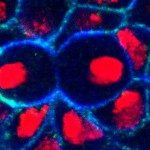Lien vers Pubmed [PMID] – 15018932
Curr. Opin. Neurobiol. 2004 Feb;14(1):6-14
One mechanism to generate daughter cells with distinct fates is the asymmetric inheritance of regulatory proteins, leading to differential gene regulation in the daughter cells. This mode of cell division is termed ‘asymmetric cell division.’ The nervous system of the fly employs asymmetric cell division, both in the central nervous system, to generate neural precursors, neurons and glial cells; and in the peripheral nervous system, to create sensory organs that are composed of multiple cell types. These cell lineages are excellent models to examine the gene expression program that leads to fate acquisition, the cell-fate determinants that control these programs and how these determinants, in turn, are distributed through cell polarity machinery.

